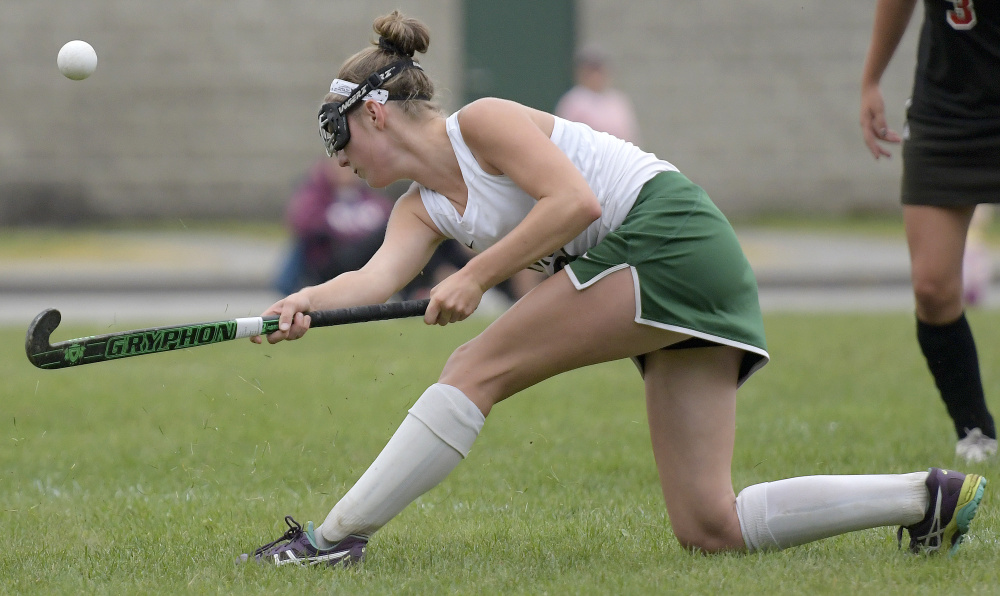The path to field hockey success can often be a bumpy one traversed over grassy fields subject to the whims of dry summers or wet autumns.
As veteran Skowhegan coach Paula Doughty says, “the game was meant to be played on turf.”
Grass or turf, the general way to get the ball from point A to point B is along the ground. Another method is the aerial pass, a maneuver not designed to avoid bumpy passes but one to move the ball quickly past the defense.
“They were popular in the ’70s and ’80s, then they went away,” Doughty said. “Back then they were called big scoops.”
Aerial passes are common in the high school game these days, a byproduct of their use on travel teams where players are generally more skilled.
“I’ve been doing them for two years,” Winthrop junior Katie Perkins said. “I learned them over the summer at Majestix camp. They use more air skills like air dribbling and aerial passes.”
A big scoop is an accurate way to describe an aerial pass since the passer, generally starts from a dead ball situation and scoops the ball over the defense, sometimes to a teammate but more often to open space where a teammate can run onto the ball.
“I think you’ll find a lot of teams are practicing it on a daily basis because of what’s going on at the college level and the national level,” Winslow coach Mary Beth Bourgoin said. “If you get a chance to go online and watch any of the men play, they use it unbelievably.”
Aerials require not only strength but honed techniques as well.
“I take a big step and get under it,” Winslow senior Haley Ward said. “The longer you hold (the ball) on your stick, the higher and farther it will go.”
Ward estimates she can fling an aerial pass from just beyond midfield to the top of the penalty circle while Perkins says one of her good passes travels 25 yards. Of course hard free hits can travel much farther, especially on turf, but that’s not always an option.
“Your hit isn’t always going to be there,” said Ward, who plays center back. “You have a wall of defenders, you need to lift it above them and get it to open space.”
Lifting the ball to open space or targeting a lone teammate is a must under the rules since lobbing a ball into a crowd is ruled dangerous.
“It’s a huge change to the game,” Messalonskee coach Katie McLaughlin said. “It’s a huge change to referees as well.”
McLaughlin said officials have three criteria to consider while the ball is in the air from start to finish and the shot leaves a lot of room for interpretation.
“Sometimes the ruling on when it’s dangerous is fuzzy,” Cony coach Holly Daigle said.
Doughty said her team uses aerials, or not, often based on how they’re called by officials, but she doesn’t deny their effectiveness. And unlike many teams, she has several players who can execute aerials.
“I would say we’re doing it a lot more than we’ve done in awhile,” she said. “If you’ve got a team that has a good press, you can go over them. Aerials are used mostly in the middle of the field.”
Aerials can be used to shoot the ball on goal as well but they more often lead to goals. At least one Perkins aerial — to junior Moriah Hajduk — resulted in a goal for the Ramblers this season. And another led to a 2-on-1 break that finished in the cage.
“She’s great at those,” said Winthrop forward senior Kinli DiBiase, who is often on the receiving end of a Perkins aerial. “We’ve all spent a little time working on it, she’s just perfected it. It’s a really good way for us to get ahead of people.”
Copy the Story LinkSend questions/comments to the editors.



Success. Please wait for the page to reload. If the page does not reload within 5 seconds, please refresh the page.
Enter your email and password to access comments.
Hi, to comment on stories you must . This profile is in addition to your subscription and website login.
Already have a commenting profile? .
Invalid username/password.
Please check your email to confirm and complete your registration.
Only subscribers are eligible to post comments. Please subscribe or login first for digital access. Here’s why.
Use the form below to reset your password. When you've submitted your account email, we will send an email with a reset code.